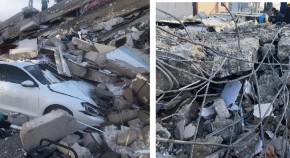
Collection
Special Issue: February 6, 2023, Kahramanmaraş-Türkiye Earthquakes (M7.7 and 7.6): Reconnaissance Missions and First Observations
- Submission status
- Closed
The February 6, 2023, Kahramanmaras-Turkiye earthquakes have caused significant damage and loss of life in the region. The damage extent, in terms of human lives and civil structures, encompasses an area of about 60,000 km2, reaching as far as 450 km from the epicenters of the two events, including the border settlements in northwestern Syria. Two devastating sequential earthquakes of magnitudes M 7.7 (epicenter in the vicinity of Pazarcık county in Kahramanmaraş province) and M 7.6 (epicenter in the vicinity of Ekinözü-Elbistan county in Kahramanmaraş province) occurred within approximately 9 hours difference on the southwest part of the Eastern Anatolian Transform Fault Zone (EATFZ). The earthquakes heavily damaged eleven provinces of Türkiye (Kahramanmaraş, Adıyaman, Elazığ, Gaziantep, Malatya, Kilis, Hatay, Adana, Diyarbakır, Osmaniye, and Şanlıurfa. As of March 9, 2023, the death toll exceeded 45,000 and almost 600k people have been evacuated from the earthquake-struck cities. The number of severely damaged and collapsed buildings are reported as approximately 250k in the eleven provinces. The city centers of Antakya (Antioch, one of the most ancient cities in the Middle East), as well as Adıyaman and Kahramanmaraş are almost completely demolished. The official reports indicate approximately 15m people have been affected by these earthquakes. The accelerograms of the two mainshocks were recorded by over 280 strong motion stations operated by AFAD, the national network operator, and other structure- and basin-specific strong motion networks.
As a consequence, there exist many issues related to tectonics, seismology, strong ground motions, and earthquake engineering that deserve to be studied in detail. This special issue will invite researchers in the fields of earth sciences, engineering seismology, soil dynamics, and earthquake engineering to publish papers and explain their findings on the below topics (and possibly others) for highlighting the most important aspects of these earthquakes:
• Geotechnical and structural damage assessments
• Strong-ground motion processing and analysis
• Forward directivity pulses and near-fault effects
• Ground-motion models
• Liquefaction
• Basin effects
• Earthquake performance of lifeline systems (roads, railroads, dams, bridges, tunnels, and major pipelines)
• Earthquake performance of urban infrastructure and municipal services
• Emergency response and recovery efforts
• Social and economic impacts of the earthquakes
Editors
-
Kemal Önder Çetin
Middle East Technical University Civil Engineering Department Dumlupinar Blv. Çankaya Ankara 06800, Turkey e-mail: ocetin@metu.edu.tr
-
Robb E. S. Moss
California Polytechnic State University College of Engineering San Luis Obispo, 93407 CA, USA
-
Ahmet Yakut
Middle East Technical University Civil Engineering Department Dumlupinar Blv. Çankaya Ankara 06800, Turkey
Articles (7 in this collection)
-

-
Analysis of impulsive ground motions from February 2023 Kahramanmaraş earthquake sequence
Authors
- Deniz Ertuncay
- Giovanni Costa
- Content type: S.I. : February 6, 2023, Kahramanmaras-Turkiye earthquakes
- Open Access
- Published: 02 April 2024
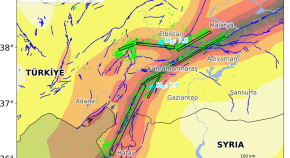
-
Soil liquefaction sites following the February 6, 2023, Kahramanmaraş-Türkiye earthquake sequence
Authors (first, second and last of 4)
- Kemal Onder Cetin
- Berkan Soylemez
- Elife Cakir
- Content type: S.I. : February 6, 2023, Kahramanmaraş-Türkiye earthquakes
- Open Access
- Published: 18 March 2024
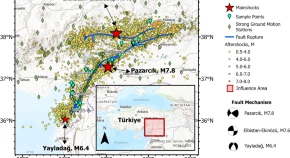
-
Emergency response, and community impact after February 6, 2023 Kahramanmaraş Pazarcık and Elbistan Earthquakes: reconnaissance findings and observations on affected region in Türkiye
Authors (first, second and last of 13)
- Meltem Şenol Balaban
- Canay Doğulu
- Ayşe Nuray Karancı
- Content type: S.I. : February 6, 2023, Kahramanmaraş-Türkiye earthquakes
- Open Access
- Published: 07 February 2024
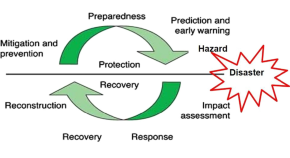
-
Characteristics of strong ground motion from the 2023 Mw 7.8 and Mw 7.6 Kahramanmaraş earthquake sequence
Authors (first, second and last of 5)
- Jinjun Hu
- Mingji Liu
- Tahir Serkan Irmak
- Content type: S.I. : February 6, 2023, Kahramanmaraş-Türkiye earthquakes
- Published: 23 January 2024
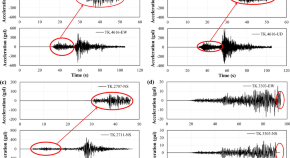
-
Destructive impact of successive high magnitude earthquakes occurred in Türkiye’s Kahramanmaraş on February 6, 2023
Authors (first, second and last of 12)
- Aydin Demir
- Erkan Celebi
- Necati Mert
- Content type: S.I. : February 6, 2023, Kahramanmaraş-Türkiye earthquakes
- Open Access
- Published: 18 January 2024

-
Damage observations of RC buildings from 2023 Kahramanmaraş earthquake sequence and discussion on the seismic code regulations
Authors (first, second and last of 6)
- Eren Vuran
- Cavit Serhatoğlu
- Ramazan Livaoğlu
- Content type: S.I. : February 6, 2023, Kahramanmaraş-Türkiye earthquakes
- Open Access
- Published: 10 January 2024



